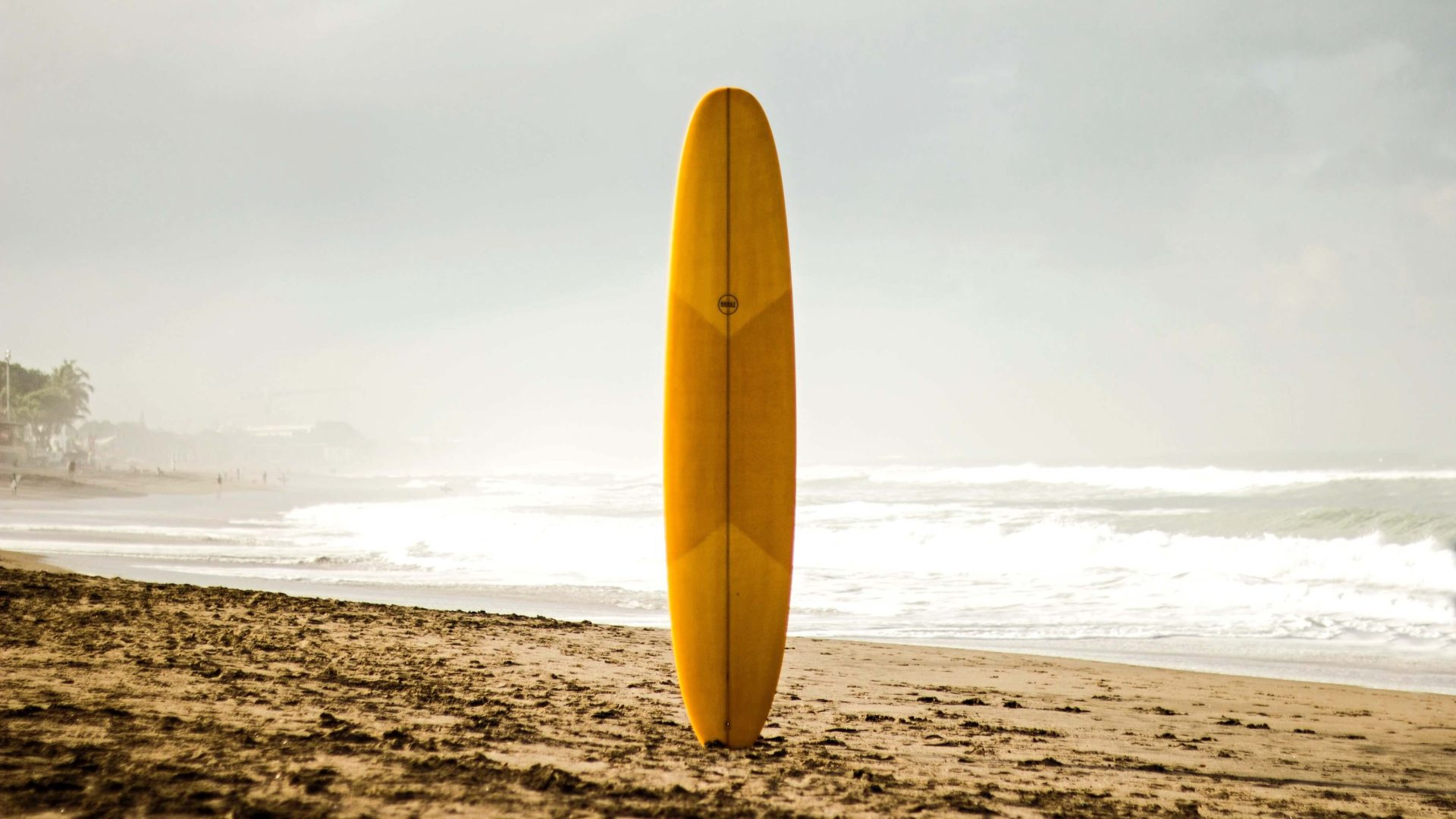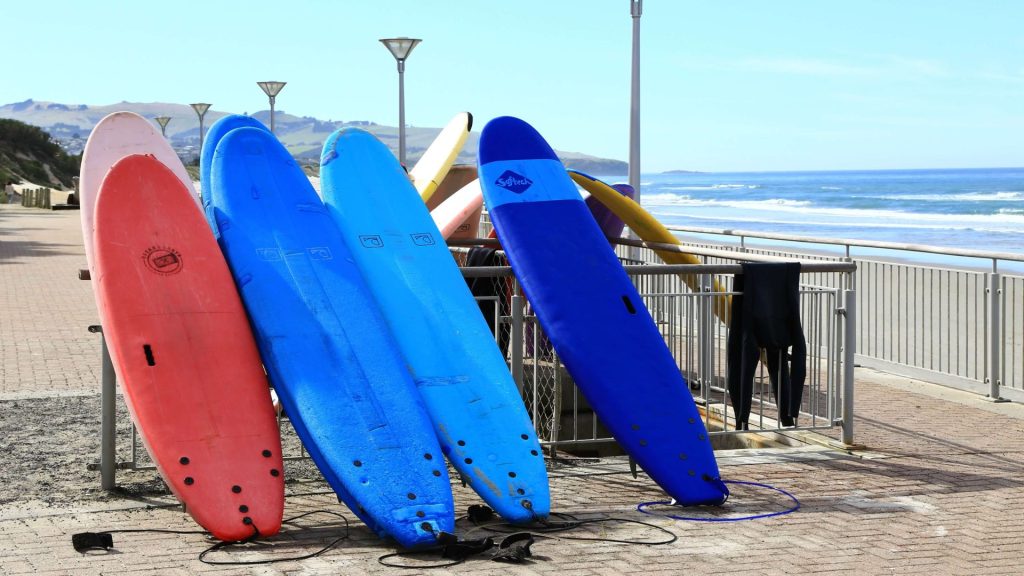Best Surfboard Size For Beginners

Understanding the best surfboard size for beginners can make or break your introduction to surfing.
Surfboard type and surfboard size for beginners is very important, as choosing the wrong board can leave you frustrated with no waves.
This guide will confirm the best surfboard size for beginners and allow you to use our surfboard size calculator so you can be sure your are on the right board!
What is the Best Surfboard Size For Beginners?
The best surfboard size for beginners is typically around 7 to 9 feet in length. These longer boards provide greater stability and make it easier for newcomers to learn how to surf.
It's important to note this will vary person to person due to different body types, weights and heights along with the type of swell they are learning in.
A good rule surfers use when selecting surfboard size for beginners is to begin with a longboard that is roughly 3 ft longer than your height.
Furthermore, beginner surfers have a choice of learning on a soft top or hard top surfboard, we go into this later on in the article.
Try the Surfboard Size Calculator below to check the best surfboard size for you when beginning your surfing journey:
Surfboard Size Calculator: Beginners
Surfboard Size For Beginners: Does It Matter?
The size of a surfboard matters because it directly affects your ability to catch waves, maintain stability, and maneuver in the water.
Choosing the right size surfboard is crucial for optimising your surfing experience and performance.
This table showcases how the size of your board can impact your surfing experience as beginner.
| Aspect | Larger Surfboard | Smaller Surfboard |
|---|---|---|
| Wave Catching Ability | Easier to catch smaller waves, ideal for beginners | Better for larger, powerful waves, not ideal for beginners |
| Stability | Offers better stability, ideal for beginners | Requires more skill to stay stable |
| Paddling Efficiency | Paddles more efficiently, reaches waves faster | Requires more effort to paddle |
| Turning and Manoeuvrability | Less manoeuvrable and responsive | More manoeuvrable and responsive |
| Experience Level | Often chosen by beginners | Suited for experienced surfers |
| Weight and Fitness | Ideal for heavier individuals | Weight and fitness are factors |
| Wave Conditions | Better for small, mushy waves | Handles bigger, powerful waves |
Want To Make a More Advanced Decision?
Use this Surfboard Volume Calculator to calculate what volume would be best suited to you.
When selecting specific surfbaord size for beginners, this is not essential. However when you switch from your soft top to a hard top it is always good to consider surfboard volume and rail type.
In summary, selecting the best surfboard size for beginners depends on your skill level, wave conditions, weight, and preferences. It's a crucial factor in determining your overall surfing experience.

Soft Top Surfboard Size For Beginners
Soft top surfboards, often called "Foamies" or "Funboards," are specially designed with beginners in mind. They feature a foam deck, which provides excellent stability and floatation, making it easier to catch waves and maintain balance while you're learning to stand up.
The recommended soft top surfboard size for beginners is 8ft with this being a common size your local surf schools. However, this will differ depending on your height and age.
You might hear the terms "soft top" and "foam surfboard" used interchangeably. These boards typically have a foam core and a soft, forgiving deck, making them perfect for beginners.
What's the Difference Between a Soft Top and a Foamie You May Ask?
Nothing, really!
Both terms refer to surfboards with foam construction. The soft top is a reference to the deck's soft, cushioned surface. Foamies, on the other hand, are named for their foam core. So, when you hear these terms, know that they're talking about the same type of beginner-friendly surfboard.
Do These Soft Top/Foamie Surfboards Need Wax?
One of the great things about soft top surfboards is that they don't require wax for traction.
The foam deck itself provides enough grip, so you can skip the waxing process that traditional surfboards need.
Soft Top Surfboard vs Hard Top
| Aspect | Soft Top Surfboard | Hard Top Surfboard |
|---|---|---|
| Stability | Very stable, ideal for beginners | Less stable, better for experienced surfers |
| Durability | Highly durable, resistant to dings | Prone to dings and damage |
| Weight | Lightweight | Heavier |
| Traction | No wax needed, foam deck provides grip | Requires wax for traction |
| Cost | Usually more affordable | Generally pricier |
When Should You Switch From a Soft Top Surfboard To a Hard Top?
Typically, once you've gained enough experience and confidence in your surfing skills, you can consider transitioning to a hard top board.
But, many surfers continue to enjoy their soft tops for years, especially if they prefer the added stability and durability.
Adults Surfboard Size For Beginners
Is It Worth Buying a Beginner Surfboard?
Investing in a beginner surfboard is a wise decision if you're serious about learning to surf mainly die to the fact it will be the correct surfboard size for beginners graduating through the learning faze.
While you can rent boards, having your own allows you to practise consistently and get comfortable with your equipment.
Beginner surfboard sizes are designed to be user-friendly, providing the best possible learning experience.
Choosing the right beginner surfboard is crucial for a smooth learning experience. Essential features include stability, buoyancy, and durability, and recommended sizes depend on your weight and skill level.
Tips For Beginner Adult Surfers
- Start with a longboard or foam board for added stability.
- Choose a size that suits your weight and experience level.
- Practice paddling, balancing, and catching small waves.
- Gradually progress to smaller boards as your skills improve.
- Get professional lessons for a faster learning curve. Remember, the right surfboard can make all the difference in your surfing journey.
In relation to adults, recommended surfboard sizes for beginners adults depend on your weight and experience level.
Generally, larger boards, such as longboards or foam boards, provide better stability and are ideal for beginners.
Beginner surfers adults or kids are advised to avoid learning on a shortboard during the first few months of surfing.
Kids Surfboard Size For Beginners
What Size Surfboard is Recommended For a Child?
When it comes to kids, choosing the right surfboard size is crucial. Look for boards specifically designed for children, with dimensions that match their age, height, and skill level. Kids' foam boards are typically lightweight, easy to paddle, and provide stability for young surfers.
For younger kids, soft-top foam boards are a popular choice due to their buoyancy and stability. These boards provide a forgiving platform for learning and are less likely to cause injuries. As your child progresses, you can transition to more traditional hard-top boards suited to their age and ability.
Longboard or Shortboard For Kids?
In relation to your kids, surfboard size for beginners is generally best to start on a longer, more stable surfboards to build their confidence and skills.
As they gain experience and grow, they can gradually transition to shorter boards.
Teaching young surfers can be enjoyable and effective by using engaging methods like games and activities that focus on improving their balance and paddling skills. Patience and positive reinforcement play a significant role in building their confidence and love for surfing.
Safety Tips for Kids Learning to Surf
When teaching kids to surf, prioritise safety by ensuring they wear proper safety gear, like a leash and rash guard, and always supervise them closely in the water. Teach them to respect the ocean, be aware of their surroundings, and follow surf etiquette to reduce risks while learning to surf.
Summing It Up: What To Do Now
Great! Now you are up to date on how to select the best surfboard size for beginners entering the surfing world! If still unsure watch this helpful video on surfboard size for beginners.
If your interested in learning more about surfing discover our many guides that will inform you on your surfing journey. Don't forget to follow us on Facebook & Instagram to stay informed on our amazing surf shots and stories shared from surf creators around the world!
Frequently Asked Questions
Can a beginner ride a 7 foot surfboard?
Yes, a beginner can ride a 7-foot surfboard, as it provides stability and ease of paddling, making it suitable for novice surfers.
How do I choose the right size surfboard?
Choosing the right size surfboard depends on your weight, height, and experience level. Generally, a longer and wider board is better for beginners.
Are shorter surfboards easier to ride?
Shorter surfboards can be more challenging for beginners due to reduced stability, making longer boards a better choice for those starting out.
How do you select surfboard size for beginners?
To select surfboard size for beginners, consider their weight, height, and skill level. Consulting with a local surf shop or using a surfboard size calculator can help determine the right fit.
Can a beginner use a 6 6 surfboard?
Absolutely, a 6'6" surfboard is a suitable option for beginners. It offers a balance between stability and manoeuvrability.
How do I choose my first surfboard?
When choosing your first surfboard, consider a longboard or foam board, typically in the 7-9 foot range. These boards offer stability and ease of learning for newcomers to surfing.


